Yeah, I really can’t overstate just how amazing a jump the transition from playing the All Aboard! Tourism demo to playing the updated retail game was. The improvements in performance and quality of life improvements that arrived with later patches were pretty noticeable. Not that performance was horrendous or anything in the demo, in handheld mode, but you can’t argue with silky smooth performance and faster loading times.
On a related tangent, looks like Artdink’s latest video is all about construction mode and creating scenarios, with English subtitles available as usual.
Please have your tickets ready for inspection by the conductor and prepare to board today’s train, as our railroading adventure in All Aboard Tourism continues!
Let’s Play All Aboard Tourism - Greasing the wheels of progress…
Click to reveal...
Gradually closing in on our scenario objectives, it is time to grease the wheels of progress as our business adventure in the All Aboard Tourism scenario continues! Today we will be continuing where we left off, which was preparing to acquire a train for our tourist route from Komita, via Nobusu, to Nagashirojo. By the end we’ll have setup a bus route between Komita and Nobusu, turning it into a tourist transfer hub, and built some subsidiaries near Nobusu Station to take advantage of the town’s expected growth.
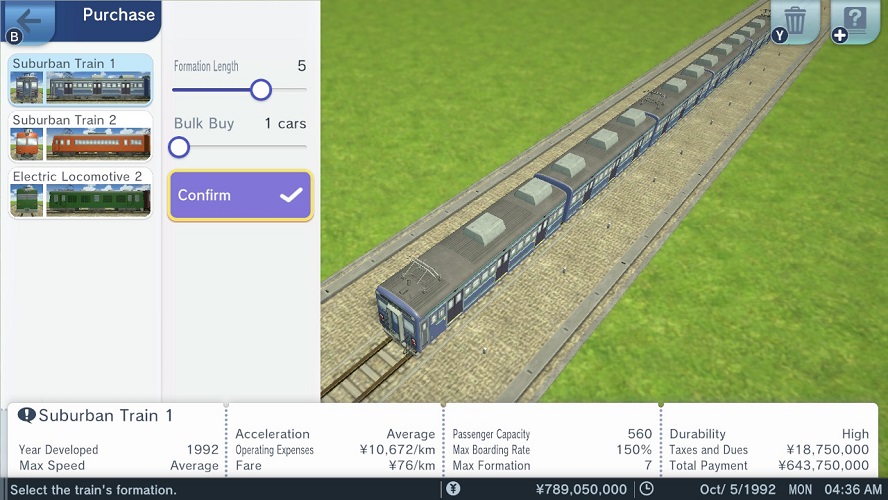
Since Komita is just a mid-sized city compared to the metropolis of Hasuoka we’re going to purchase some new, and better, rolling stock for our Hasuoka-Nagashirojo line. We’ll replace one of our older trains with our new train and then use the older train to provide service on our Nobusu-Nagashirojo line. As demand for our Hasuoka-Nagashirojo services is often outstripping supply the improvements in passenger capacity should be much appreciated.

With the Suburban 2 type train that was operating the 6:30am service from Hasuoka to Nagashirojo replaced with our newly purchased Suburban 1 type train. We’ll now place our freshly withdrawn train near Nobusu station, where it can park up for the night before beginning services from Nobusu to Nagashirojo. Set to depart from Nobusu Station at 7:00am, the service will complete a full loop every two hours and depart five times a day.
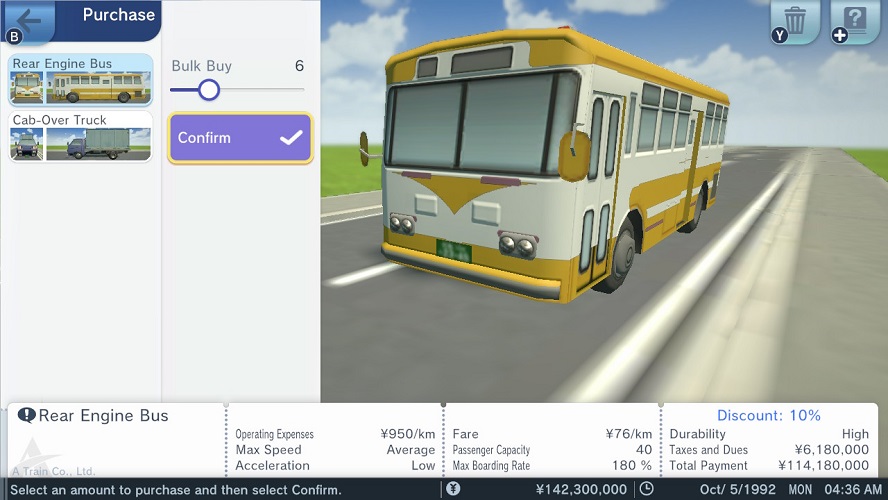
Afterwards, we’ll purchase six buses to begin operating between Komita and Nobusu. This bus service will ensure we now offer a complete tourist route from Komita to Nagashirojo. As previously said, the activity of the tourists in the town of Nobusu as they wait for the connecting train service to Nagashirojo should boost the town’s growth.
Unsurprisingly, comparing and purchasing buses works similarly to trains. Currently, we only have one model of bus available to us but in the future we would be able to compare operating costs, fare per kilometer, and other important statistics when deciding between two or more options.
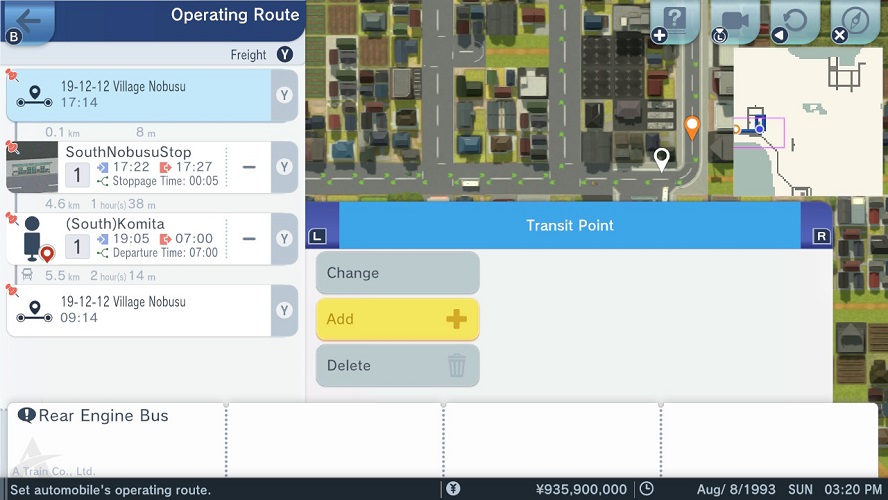
Setting up the operating route of a bus is similar in many ways to the steps we took for our trains. However, one important difference is that road-based vehicles use a waypoint system to guide them. The route a bus will take to reach one waypoint from another is automatically calculated by the vehicle for us. Meaning that we can either let the bus’ automatic navigation do the heavy lifting for us or add in more waypoints if we want to define a more specific path between destinations. It is important to remember that where we place our bus will become a permanent waypoint on its route, which we can use to help define an exact route we want our bus to take.
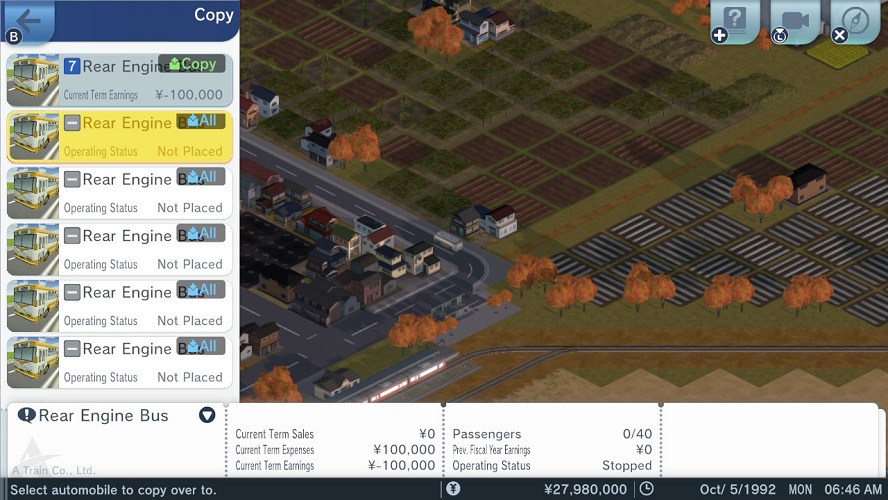
Using the Copy functionality we can minimize the amount of tinkering we need to do with each bus’ operating schedule. After pasting across the settings established for our first bus from here on out we will only need to adjust departure time from Komita and which of Nobusu’s two bus stands each bus will utilise. For this we are going to adopt a simple alternating schedule of odd numbered buses using Stand #1 and even numbered buses using Stand #2. Meanwhile, our first bus will depart from Komita at 6:00am and each subsequent bus will depart 15 minutes later in the morning.

After letting things run for 16 in-game days we begin construction of West Nagashiro Station to connect the local populace of the town, within the Nagashiro district, to our transit network. Subsequently, seven days later on October 28th our newest railway station is constructed and opens for business. As our Nobusu to Nagashirojo service will be passing through our new station during it’s journey West Nagashiro Station has been automatically added to our train’s operating route settings, with a stopping time of five minutes assigned by default.
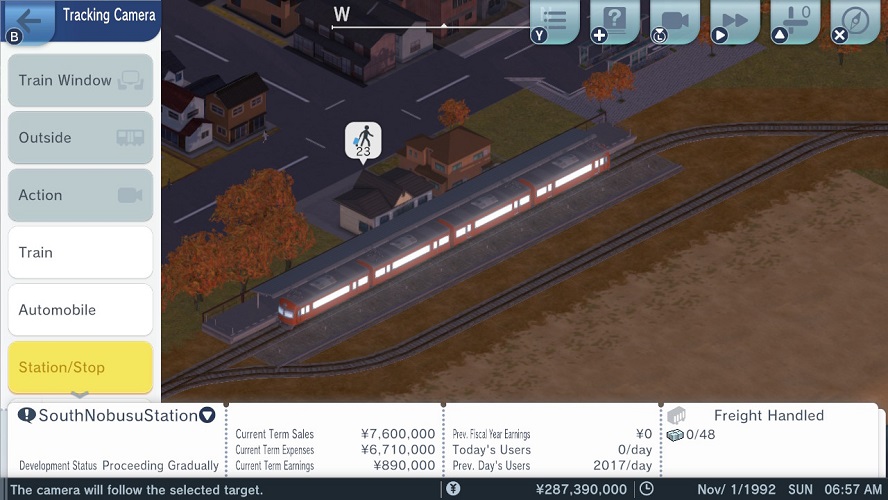

We subsequently step away again for a period of sixteen days to let our company accumulate some more funds. After eight months in operation of the region’s transportation needs now might be a good time to consult our income statement and see how our finances are progressing for this financial year. As we can see from the picture below, we are currently achieving net earnings of 402,530,000 Yen. So, well on our way to hopefully achieving a profit by the end of the financial year once taxes and other expenses have been accounted for.
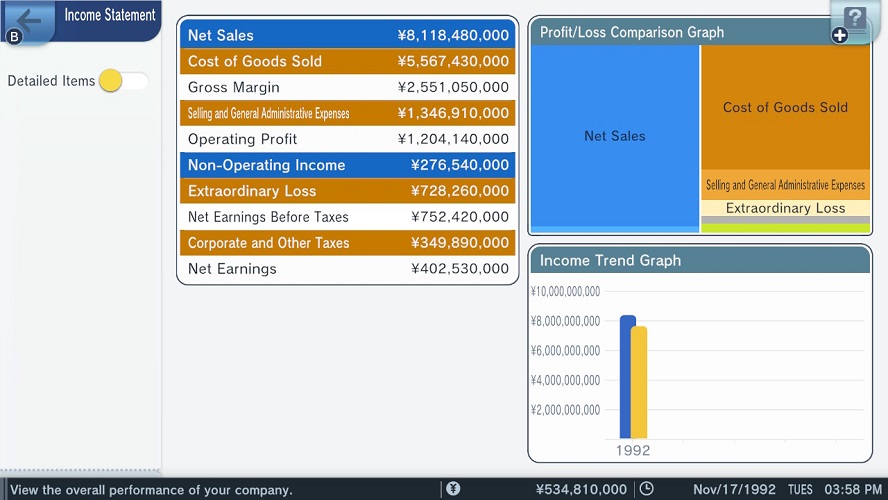
Checking back on our train station and bus stop in Nobusu, we can see that the influx of tourists has elevated the development status up to “Proceeding Gradually” and “Proceeding Well” respectively. Consequently, the Nobusu township is beginning to experience a raft of urban development projects that will boost the population and attractiveness of the township. Never one to turn up an opportunity to generate new sources of revenue, our company will contribute to this wave of development by constructing some subsidiaries near our transit options.

We first begin by constructing a Drive-Through eatery nearby our train station and bus stop, which should be a beneficial symbiosis.

Afterwards we continue our construction spree by building a couple of small housing complexes next door to our bus stop. Which should also prove to be a beneficial symbiosis in the long run.

We then follow that up by constructing a residential apartment block next door to the Nobushu train station. Once again displaying the potential to achieve some good synergy with our nearby transportation stops, by providing potential passengers.
During December 28th we begin the construction of a gas station in Nobushu township and subsequently receive new from our secretary that our company now owns 10 subsidiaries. A number which will only continue to grow over the course of the scenario as we help boost development in the region and push the population to our objective of 20,000 people.

Construction of our gas station is completed on the afternoon of January 8th and swiftly opens for business. Which now allows us to examine another gameplay aspect of the modern A-Train games. Similarly to how we can buy and sell land, we can may also buy and sell subsidiaries on the real estate market. Therefore, if we are strategic in where, when and what subsidiaries we construct our company can generate revenue by becoming a property developer.
Rather than constructing subsidiaries for the longer term operating profits we hope they achieve we can instead develop, or redevelop, land and then sell the newly developed land and associated building\business on the open market. There are two options when choosing to sell a subsidiary, the “Find Buyer” and “Quick Sell” options. The “Quick Sell” option speaks for itself and represents wanting to sell a subsidiary instantly for whatever knockdown price someone will buy it for. Alternatively, the “Find Buyer” option often won’t result in an instant sale, however, it will net us the best price and can often lead to selling our fixed assets for a profit.
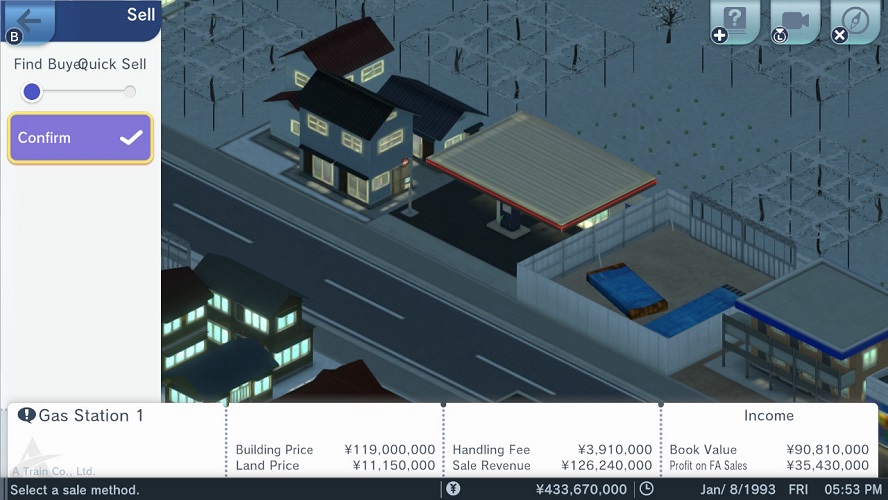
As pictured above, when selling subsidiaries the assessed value of the building and land, and the sales revenue generated are taken into account when deriving the sale price. Of course, any transaction will also incur a handling fee as well. The difference between the book value of the subsidiary to our company and the sale price is the fixed asset profit or loss we will generate selling the subsidiary. This particular strategy can be most beneficial in scenarios with short completion time frames where an instant infusion of Yen is more beneficial to our business plans than a slow, steady influx of revenue.

Taking in the sights of the development that has occurred around Nobushu township, we conclude the chronicling of our business adventures for now. I do hope you can join me next time as we make one final push to reach our completion conditions for the scenario. Where we will usher in a new financial year, see how we performed for the current financial year, discuss taxes and tax payments, discuss shareholder confidence, pay out our first ever dividend to our private shareholders, and more.
Until the next time we met aboard the A-Train, I hope you have a safe and enjoyable journey!
